October 22, 2020 feature
Shedding light on moiré excitons: A first-principles perspective

Thamarasee Jeewandara
contributing writer
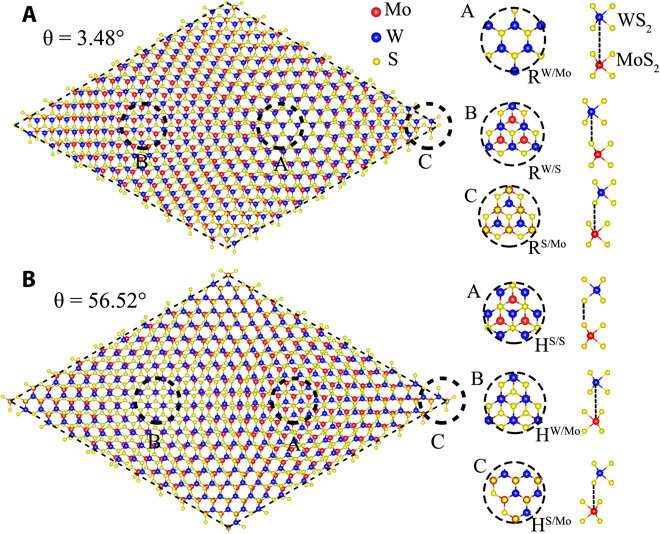
Moiré superlattices that are located within van der Waals (vdW) heterostructures can trap long-lived interlayer to form ordered quantum dot arrays, paving the way for unprecedented optoelectronic and quantum information applications. Excitons are an electrically neutral quasiparticle that can transport energy without transporting net electric charge. They form when a material absorbs a photon of higher energy than its bandgap and the concept can be represented as the bound state of an electron and an electron hole that are attracted to each other by an electrostatic Coulomb force. In a new report now published on Science Advances, Hongli Guo and a team of scientists in the department of physics and astronomy at the California State University, Northridge, U.S., performed first-principles simulations to shed light on moiré excitons in twisted molybdenum disulfide/ tungsten disulfide (MoS2/WS2 ) heterostructures. The team showed direct evidence of localized interlayer moiré excitons in vdW heterostructures and mapped out the interlayer and intralayer moiré potentials based on energy gaps. They noted nearly flat valence bands in the heterostructures while exploring how the vertical field could be tuned to control the position, polarity, emission energy and hybridization strength of the moiré excitons. The scientists then predicted that the alternating electric fields could control the dipole moments of hybridized moiré excitons, while suppressing their diffusion in moiré lattices.
Engineering a van der Waal heterostructure
In this work, Guo et al. used a newly developed computational method to provide direct evidence of localized interlayer moiré excitons in vdW heterostructures and proposed the formation of hybrid moiré excitons under alternating electric fields, to suppress the diffusion of excitons within moiré lattices. The most appealing method to is by introducing a lattice mismatch or rotation misalignment between the two-dimensional (2-D) layers to form a moiré superlattice with new length and new energy scales for fascinating quantum phenomena. Van der Waal (vdW) heterostructures formed in this way with vertical stacks of 2-D crystals provides an unprecedented platform to develop quantum materials with exotic physical properties such as , and .
After initial theoretical predictions, researchers had reported a number of experimental observations of moiré excitons in vdW heterostructures of (TMDs). The 2-D TMDs showed prominent excitonic effects due to quantum confinement and reduced dielectric screening. Although research work led to a surge of experimental and theoretical research on moiré excitons in vdW heterostructures, the first principles perspectives on the subject remain scarce due to computational challenges. Studies on first principles remain important since they can provide critical insight on the atomistic level of detail beyond experimental reach and phenomenological theories, while remaining an indispensable tool to explore the large and ever-increasing family of vdW heterostructures.
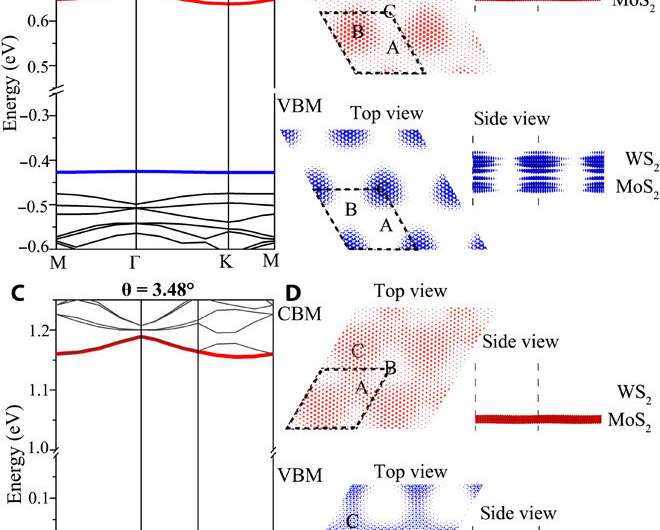
Moiré potential and controlling the local bandgap
The unit cells of two moiré superlattices can be formed by twisting a molybdenum disulfide/ tungsten disulfide (MoS2/WS2) bilayer (group of transition metal dichalcogenide materials), where the unit cells maintain a similar lattice constant and number of atoms. There are three local motifs in both superlattices (labeled A, B and C) that preserve the threefold rotational symmetry and play a crucial role to determine the properties of moiré lattices. The atomic structures of these motifs are, however, different for the two superlattices. The team mapped out the maximum amplitude of the moiré potentials – the most important property of moiré superlattices and calculated the energy bandgap of the MoS2/WS2 bilayer. They used the bandgap modulation to understand the moiré potentials and noted the amplitude of the interlayer moiré potentials to be much greater than the intralayer moiré potentials, where the interlayer moiré excitons were more localized than the intralayer moiré excitons.
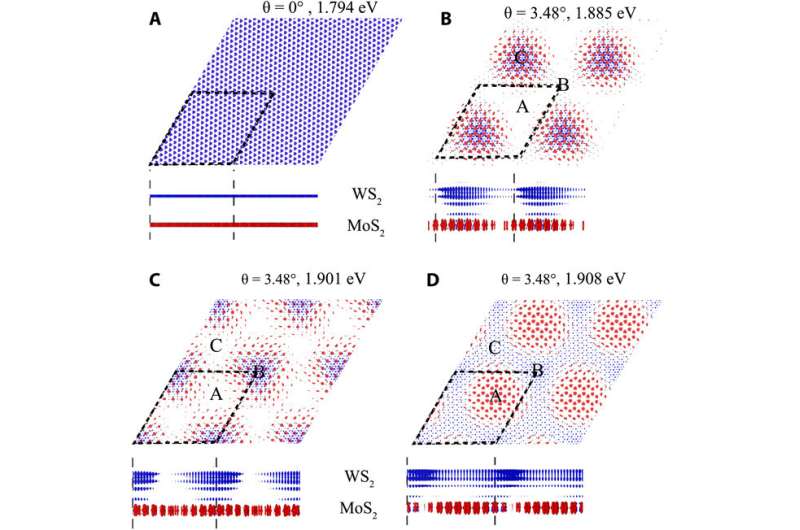
A first principles approach
Conventionally, physicists use the (BSE) method based on the many-body perturbation theory. However, the method is expensive for moiré excitons due to the large number of atoms in the unit cell. To overcome the problem, Guo et al. developed to provide a reliable description of excitonic effects without excessive computational costs. They based the method on (TDDFT) and examined moiré excitons in the twisted MoS2/WS2 heterostructures with different angles. As the twist angle increased, the moiré potential became shallower and the excitons became less localized to provide first direct evidence of localized moiré excitons in vdW heterostructures from first principles. The team thereafter determined the exciton binding energy in a variety of MoS2/WS2 heterostructures.
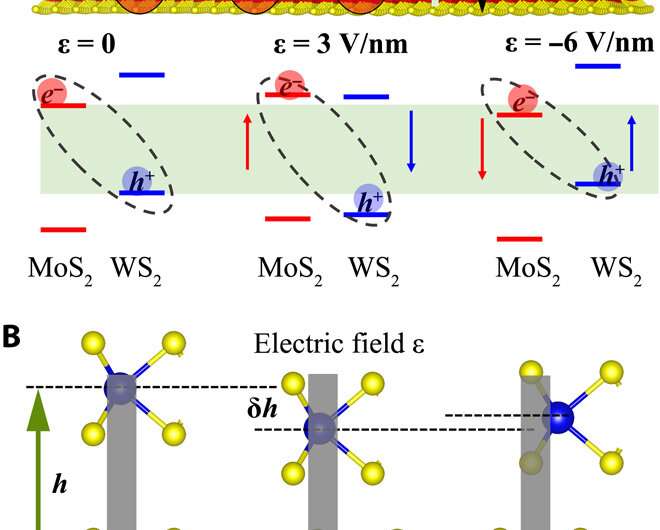
Electrically tuning moiré exciton positions
The scientists then schematically represented an experimental setup that allowed electrical control of excitonic properties. While a positive electric field pointing from the tungsten disulfide (WS2) to the molybdenum disulfide (MoS2) layer could increase the energy of MoS2 while lowering the energy of WS2, the effects were vice versa for a negative electric field. When applying a positive field, the electron and hole of moiré excitons also switched layers to form an interlayer moiré with the opposite polarity. Furthermore, a negative field could reduce the energy gap of the heterostructure and the energy of the interlayer excitons. In this way, Guo et al. used the electric field to tune and program the location, polarity, and emission energy of moiré excitons to control quantum information carriers on demand. Even though the moiré excitons are localized, they can tunnel through the moiré potentials and , therefore the ability to control either enhanced or suppressed exciton diffusion is also of interest at present.
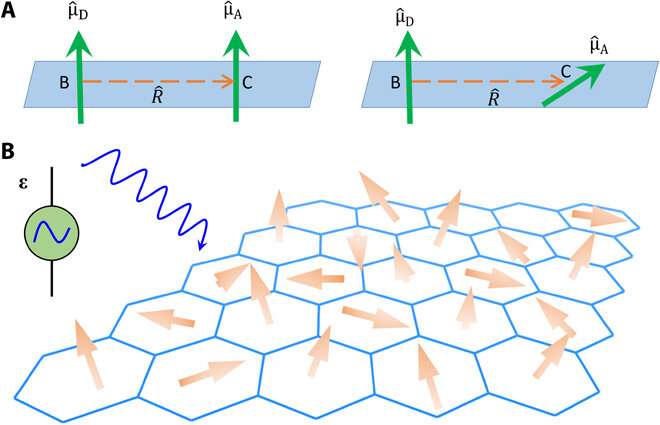
In this way, the large family of two-dimensional materials presented an unprecedented engineering opportunity in quantum materials, specifically relative to 2-D transition metal dichalcogenide (TMD) heterostructures with potential applications as quantum emitters or . Understanding, predicting and controlling moiré excitons in vdW heterostructures is of great scientific importance, although highly challenging. Hongli Guo and colleagues used first-principles simulations to address the challenges and offer critical insights at the atomic and electronic scale that have hitherto remained unknown. They determined the distribution of exciton charge densities in twisted molybdenum disulfide/tungsten disulfide (MoS2/WS2) heterostructures by using first-principles calculations to provide direct evidence of localized moiré excitons in TMD heterostructures. The team also showed how the vertical field could be tuned to control the position, polarity, emission energy and hybridization strength of the moiré excitons. The team predict that alternating electric fields could suppress the diffusion of moiré excitons in 2-D materials.
Written for you by our author —this article is the result of careful human work. We rely on readers like you to keep independent science journalism alive. If this reporting matters to you, please consider a (especially monthly). You'll get an ad-free account as a thank-you.
More information: Hongli Guo et al. Shedding light on moiré excitons: A first-principles perspective, Science Advances (2020).
Yuan Cao et al. Unconventional superconductivity in magic-angle graphene superlattices, Nature (2018).
Mit H. Naik et al. Ultraflatbands and Shear Solitons in MoirĂ© Patterns of Twisted Bilayer Transition Metal Dichalcogenides, Â鶹̉ùÔºical Review Letters (2018).
Journal information: Science Advances , Nature , Â鶹̉ùÔºical Review Letters
© 2020 Science X Network

















